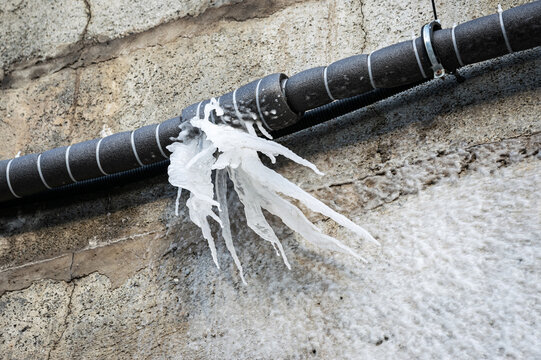This article listed below relating to Prevent Frozen Pipes is really insightful. Give it a try and make your own personal conclusions.

Cold weather can wreak havoc on your pipes, especially by freezing pipes. Right here's just how to stop it from taking place and what to do if it does.
Introduction
As temperature levels decrease, the danger of frozen pipes boosts, possibly causing expensive repair services and water damages. Comprehending how to avoid frozen pipelines is crucial for home owners in cool environments.
Avoidance Tips
Insulating at risk pipelines
Cover pipes in insulation sleeves or make use of heat tape to shield them from freezing temperature levels. Focus on pipelines in unheated or external areas of the home.
Home heating techniques
Keep interior spaces sufficiently heated, specifically areas with plumbing. Open up cupboard doors to enable cozy air to distribute around pipelines under sinks.
Exactly how to recognize frozen pipes
Search for lowered water circulation from faucets, unusual odors or noises from pipelines, and visible frost on revealed pipelines.
Long-Term Solutions
Structural adjustments
Consider rerouting pipelines away from exterior wall surfaces or unheated areas. Add additional insulation to attic rooms, basements, and crawl spaces.
Upgrading insulation
Purchase top notch insulation for pipes, attics, and walls. Appropriate insulation assists keep regular temperatures and decreases the danger of frozen pipes.
Shielding Outside Pipes
Yard hose pipes and outdoor faucets
Disconnect and drain garden tubes before winter season. Set up frost-proof spigots or cover outside taps with insulated caps.
Recognizing Icy Pipes
What triggers pipelines to ice up?
Pipes ice up when revealed to temperatures below 32 ° F (0 ° C) for prolonged durations. As water inside the pipelines ices up, it increases, taxing the pipeline wall surfaces and possibly creating them to rupture.
Dangers and damages
Frozen pipes can result in water system disturbances, building damages, and expensive repair work. Ruptured pipelines can flooding homes and trigger extensive structural damages.
Indicators of Frozen Piping
Recognizing frozen pipelines early can avoid them from bursting.
What to Do If Your Pipes Freeze
Immediate activities to take
If you presume icy pipes, maintain taps open to alleviate pressure as the ice thaws. Utilize a hairdryer or towels taken in hot water to thaw pipelines slowly.
Verdict
Preventing icy pipelines needs aggressive measures and fast responses. By comprehending the reasons, indications, and safety nets, house owners can protect their plumbing throughout winter.
6 Proven Ways to Prevent Frozen Pipes and Protect Your Home
Disconnect and Drain Garden Hoses
Before winter arrives, start by disconnecting your garden hoses and draining any remaining water. Close the shut-off valves that supply outdoor hose bibs and leave the outdoor faucet open to allow any residual water to drain. For extra protection, consider using faucet covers throughout the colder months. It’s also important to drain water from any sprinkler supply lines following the manufacturer’s directions.
Insulate Exposed Pipes
Insulating your pipes is an effective way to prevent freezing. Pipe insulation is readily available at home improvement stores and is relatively inexpensive. Pay close attention to pipes in unheated areas such as the attic, basement, crawl spaces, or garage. Apply foam insulation generously to create a buffer against the cold. You can also wrap your pipes in heat tape or thermostat-controlled heat cables for added warmth.
Seal Air Leaks
Inspect your home for any cracks or openings that could let in cold air. Seal any holes around the piping in interior or exterior walls, as well as the sill plates where your home rests on its foundation. Additionally, make sure to keep your garage door closed unless you’re entering or exiting. Leaving it open creates a significant air leak that can lead to frozen pipes.
Allow Warm Air Circulation
During cold snaps, it’s essential to allow warm air to circulate evenly throughout your home. Leave interior doors ajar to promote better airflow. Open kitchen and bathroom cabinets to help distribute heat consistently around the rooms. If you have small children or pets, be sure to remove any household chemicals or potentially harmful cleaners from open cabinets for safety.
Let Faucets Drip
A small trickle of water can make a big difference in preventing ice formation inside your pipes. When temperatures drop significantly, start a drip of water from all faucets served by exposed pipes. This continuous flow helps prevent the water from freezing. Additionally, running a few faucets slightly can relieve pressure inside the pipes, reducing the chances of a rupture if the water inside does freeze.
https://choateshvac.com/6-proven-ways-to-prevent-frozen-pipes-and-protect-your-home/

I stumbled upon that piece of writing about Prevent Frozen Pipes while perusing the web. So long as you appreciated our blog entry please don't forget to share it. Thank you for your time. Revisit us soon.
Book Appointment Now
Comments on “Essential Tips to Prevent Frozen Plumbing in Winter: Specialist Guidance”